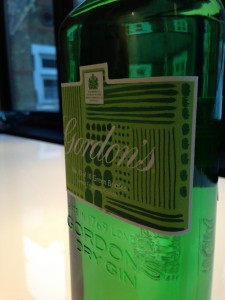Gin: What’s the difference between Gordon’s and Bombay?
How did we end up with this bottle? My husband and I don’t drink gin so it would be hard to believe that we purchased it. It must have been something left to us as an offering following one of our legendary karaoke parties.
So here I am with a full bottle of Gordon’s London Dry Gin but it seems like I can’t make anything with it…or can I?
The problem is all of the potential recipes I am reading about call for Bombay London Dry Gin. I’d like to say there can’t be a difference in using one gin instead of the other but I’m the girl who likes to lecture on good tequila. Surely there must be a gin-drinking equivalent of me ready to spit in my direction.
So to start with, where does gin come from? My Diffords Guide tells me that to produce a decent gin, it requires at least two steps. You start with a “neutral spirit,” which gets flavoured through re-distillation with seeds, berries, roots, fruits and herbs and spices – collectively known as “botanicals.” All gins must contain juniper.
Individual distillers use completely different recipes of botanicals, but Diffords says there are three main extraction processes.
The “one-shot method” macerates the botanicals in a neutral spirit and water before it is distilled. The “two-shot method” macerates a much stronger mix of botanicals before distilling it. This is then mixed with a neutral spirit.
The final method –the vapour infusion method – is more unusual but it’s used notably by Bombay. With this technique, the mix of botanicals does not come in contact with the liquid spirit. Instead, they are placed in baskets inside elaborate modified stills and only encounter the spirit as steam, according to Diffords. The final result is a botanical-infused spirit.
Bombay Original is flavoured with eight botanicals, Diffords says. They include: juniper berries from Tuscany, coriander seeds from Morocco, angelica root from Dresden in Germany, liquorice from China, iris root from Italy, cassia bark from Indo-China, almonds and lemon peel from Spain.
Wow. Think of all the shipping and flying required to get those into one bottle. Imagine the carbon footprint! I digress.
Gordon’s says what gives its gin a unique taste is the way it uses juniper. Its website states that the juniper berries are shaken from the tree and stored for two years to intensify the oils and mellow the flavours. In addition to juniper, Gordon’s recipe also includes coriander seeds, angelica root, liquorice, iris root, orange and lemon peel. The website says the gin’s coriander gives a dry and citrus taste. It describes angelica as “the magic ingredient” that ties together the other botanicals – adding complexity.
Gordon’s is not quite as open about its extraction process. It only gives customers this bit of information: “Gordon’s is triple distilled to guarantee the purity of the gin, and the exact blend of our botanicals has remained a closely guarded secret.”
Perhaps Bombay might be better but I am not willing to shell out the extra cash for it when I seemingly have a very good gin here ready for use. So keep your eyes on the site tomorrow when I reveal my first gin cocktail.
